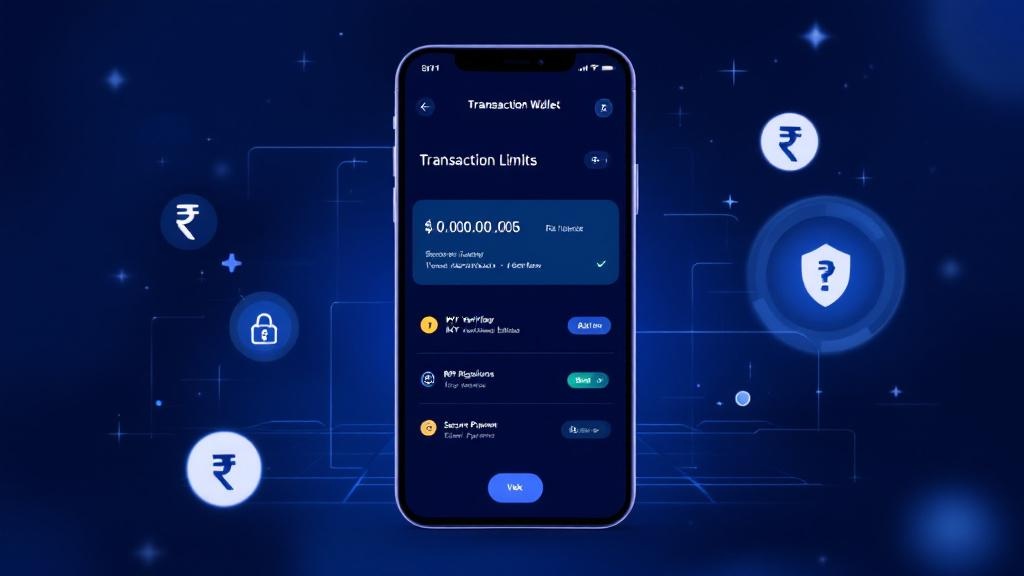Digital wallets have become an essential part of our daily lives—whether it’s paying for groceries, booking a cab, or splitting dinner with friends. But as seamless as digital payments feel, there are still important rules and restrictions behind the scenes, especially around how much you can spend or transfer. These are known as digital wallet transaction limits, and in 2025, they’ve become more relevant than ever.
In this guide, we’ll break down everything you need to know about wallet limits, KYC thresholds, and how to stay within your digital wallet’s caps. If you’ve ever hit a limit while trying to make a payment, this article is for you.
🔍 What Are Digital Wallet Transaction Limits?
Digital wallet transaction limits refer to the maximum amount of money you can send, receive, or spend using a digital wallet within a specific time frame. These limits are set by wallet providers and governed by regulatory bodies like the Reserve Bank of India (RBI) to prevent fraud, promote secure transactions, and ensure financial compliance.
Depending on the type of wallet account you hold and your KYC status, these limits can vary significantly.
🧾 Types of Digital Wallet Accounts in 2025
Digital wallets in India are broadly classified into two types:
1. Minimum-KYC Wallets
No full identity verification needed
Meant for basic use
Limited functionality
2. Full-KYC Wallets
Requires full PAN + Aadhaar verification
Unlocks full wallet features
Higher limits for spending and transfers
➡️ Long-Tail Keyword Integration: wallet account type, wallet upgrade benefits
Upgrading from a minimum-KYC to full-KYC wallet comes with real perks—higher wallet limits, better security features, and more seamless usage.
💡 RBI Rules and Wallet Transaction Caps in 2025
The RBI limit on wallet transactions in India governs how much users can load, hold, and transfer via digital wallets. As of 2025:
| Transaction Type | Minimum-KYC Wallet | Full-KYC Wallet |
|---|---|---|
| Wallet Load Limit (Monthly) | ₹10,000 | ₹2,00,000 |
| Wallet Balance Cap | ₹10,000 | ₹2,00,000 |
| Daily Spending Limit | ₹10,000 | ₹50,000 – ₹1,00,000 |
| P2P Transfer | Not Allowed | Allowed up to cap |
✅ Secondary Keywords Used: daily limit for digital payments, wallet KYC limit, digital payment ceiling, e-wallet transaction cap
📲 Factors Affecting Digital Wallet Transaction Limits
1. KYC Completion
Completing your wallet KYC is the most effective way to increase your spending limit.
Wallet limit after full KYC: Once verified, your wallet’s monthly limit jumps from ₹10,000 to ₹2 lakh.
2. Wallet Provider’s Internal Policies
Even with RBI’s rules, each provider may set their own online wallet spending limits based on your usage pattern.
3. Transaction Velocity Checks
Wallets monitor the frequency of transactions—known as velocity checks—to detect unusual activity.
➡️ Example: Making 50 small payments in a day may trigger a freeze, even if the total value is low.
4. Fraud Risk and Security Triggers
To prevent scams, most wallets use AI-powered digital payment fraud prevention techniques. Suspicious spikes may limit your ability to transact further that day.
✅ LSI Keywords Used: transaction velocity checks, secure digital payments, spending controls in e-wallets
📈 How to Increase Your Wallet Transaction Limits
✅ Upgrade to Full KYC
Submit your Aadhaar, PAN, or do a quick video KYC. This unlocks:
Higher spending and loading limits
Person-to-person (P2P) transfers
Linkage to your bank account
✅ Link a Bank Account
By linking your digital wallet to your savings account, you can bypass wallet limits for higher-value transactions via UPI or Netbanking.
✅ Use Payment Aggregator Services
Platforms using payment aggregator limits often extend the effective transaction caps when linked to your wallet.
🧮 Real-Life Example
Let’s say you use a wallet to pay for groceries and online shopping.
If you’re on a minimum-KYC wallet, you’ll hit the monthly limit for wallet usage at ₹10,000.
But if you’re a freelancer paying vendors or running ads, upgrading to a full-KYC wallet is crucial. You could need ₹50,000–₹1,00,000 in monthly capacity.
Always plan ahead to avoid failed transactions.
🔐 Daily and Monthly Monitoring: How It Works
Digital wallets now employ daily transaction monitoring powered by AI and machine learning. These systems track:
Number of transactions
Amount per transaction
Total value per day/month
Risk factors like location changes or suspicious patterns
➡️ Long-Tail Keyword Example: fintech usage caps, electronic money policies
This kind of intelligent monitoring helps detect fraud and keep users safe.
🛡️ Common Digital Wallet Limit Myths (Busted)
❌ Myth 1: There’s no limit on UPI if linked via wallet
Truth: UPI has its own limit—₹1 lakh per transaction. Wallets still impose limits when used for loading or spending.
❌ Myth 2: You need to visit a store for KYC
Truth: Most wallets now support video KYC—no store visit needed.
❌ Myth 3: Minimum-KYC is “good enough”
Truth: That ₹10,000 monthly cap disappears fast—opt for full KYC to unlock real functionality.
❓ FAQs: Digital Wallet Transaction Limits in 2025
1. What is the daily limit for digital payments via wallet?
For minimum-KYC wallets, it’s usually ₹10,000. For full-KYC wallets, it ranges between ₹50,000 to ₹1 lakh, depending on the provider.
2. How can I increase my wallet limit after full KYC?
By completing full KYC and regularly using your wallet, most providers automatically upgrade your transaction thresholds over time.
3. What is the minimum transaction amount in a digital wallet?
There’s usually no minimum, but some vendors or services may require payments of ₹1 or more.
4. Does the RBI control wallet transaction limits?
Yes, RBI regulates ceiling limits, but individual wallets may add their own caps for additional safety.
5. How does daily transaction monitoring help me?
It helps detect unauthorized usage, suspicious transfers, and fraud attempts. You’ll get alerts or blocks if your activity looks risky.
6. Can wallets be used without KYC in 2025?
Yes, but only for basic services like mobile recharges. You’ll be stuck with low monthly limits and no P2P transfers.
7. Are wallet transaction limits the same for all providers?
No. While RBI sets a general policy, each provider sets specific limits based on risk and user behavior.
📝 Final Thoughts: Plan Ahead for Seamless Digital Wallet Use
In 2025, digital wallets are safer, smarter, and more regulated than ever. But to make the most of them, understanding digital wallet transaction limits is key.
Whether you’re sending money to family, shopping online, or running a small business, hitting a payment cap can be frustrating. Stay proactive—complete your wallet KYC, understand your wallet account type, and keep track of your daily and monthly limits.
By staying informed, you not only ensure smoother transactions but also protect your finances in the evolving world of electronic money policies.








Comments (0)